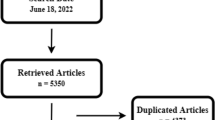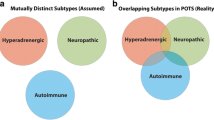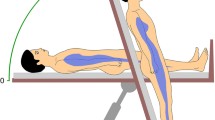Abstract
Although fibromyalgia (FM) syndrome is defined by chronic widespread pain and tenderness, additional symptoms, including disabling fatigue and dizziness, are often reported by patients with this chronic illness. Although nonrestorative sleep may play an important role for chronic fatigue in FM, other mechanisms, including dysfunction of the autonomic nervous system (ANS), need to be considered. Many important biological functions, such as heart rate, blood pressure, respirations, and bowel function, are tightly regulated by the ANS. However, dysfunction of the ANS is common in FM and often becomes quite apparent after positional changes from supine to upright. Although such positional changes sometimes result in syncope, they are more often associated with palpitations and dizziness. Head-up tilt table testing can be used to evaluate autonomic dysfunction and is frequently helpful for the work-up of FM complaints, including fatigue, dizziness, and palpitations. One of the most common events experienced by FM patients during tilt table testing is postural orthostatic tachycardia syndrome, which is defined as a heart rate increase of more than 30 beats per minute after more than 3 minutes of standing upright.
Similar content being viewed by others
References and Recommended Reading
Thieben MJ, Sandroni P, Sletten DM, et al.: Postural orthostatic tachycardia syndrome: the Mayo Clinic experience. Mayo Clin Proc 2007, 82:308–313.
Low PA, Opfer-Gehrking TL, Textor SC, et al.: Postural tachycardia syndrome (POTS). Neurology 1995, 45:S19–S25.
Brunner LS, Suddarth DS: Assessment of cardiovascular function. In Brunner and Suddarth’s Textbook of Medical-Surgical Nursing, edn 7. Edited by Smeltzer SC, Bare BG. Philadelphia: Lippincott, Williams & Wilkins; 2000:532–563.
Stewart JM, Taneja I, Medow MS: Reduced central blood volume and cardiac output and increased vascular resistance during static handgrip exercise in postural tachycardia syndrome. Am J Physiol Heart Circulatory Physiol 2007, 293:H1908–H1917.
Hoeldtke RD, Davis KM: The orthostatic tachycardia syndrome: evaluation of autonomic function and treatment with octreotide and ergot alkaloids. J Clin Endocrinol Metab 1991, 73:132–139.
Stewart JM, Montgomery LD: Regional blood volume and peripheral blood flow in postural tachycardia syndrome. Am J Physiol Heart Circ Physiol 2004, 287:H1319–H1327.
Streeten DH, Anderson GH Jr: Delayed orthostatic intolerance. Arch Intern Med 1992, 152:1066–1072.
Stewart JM: Pooling in chronic orthostatic intolerance: arterial vasoconstrictive but not venous compliance defects. Circulation 2002, 105:2274–2281.
Benditt DG, Sutton R: Tilt-table testing in the evaluation of syncope. J Cardiovasc Electrophysiol 2005, 16:356–358.
Matsushima R, Tanaka H, Tamai H: Comparison of the active standing test and head-up tilt test for diagnosis of syncope in childhood and adolescence. Clin Auton Res 2004, 14:376–384.
Raj SR, Robertson D: Blood volume perturbations in the postural tachycardia syndrome. Am J Med Sci 2007, 334:57–60.
Goldstein DS, Holmes C, Frank SM, et al.: Cardiac sympathetic dysautonomia in chronic orthostatic intolerance syndromes. Circulation 2002, 106:2358–2365.
Grubb BP, Kanjwal Y, Kosinski DJ: The postural tachycardia syndrome: a concise guide to diagnosis and management. J Cardiovasc Electrophysiol 2006, 17:108–112.
Karas B, Grubb BP, Boehm K, Kip K: The postural orthostatic tachycardia syndrome: A potentially treatable cause of chronic fatigue, exercise intolerance, and cognitive impairment in adolescents. Pacing Clin Electrophysiol 2000, 23:344–351.
Benrud-Larson LM, Dewar MS, Sandroni P, et al.: Quality of life in patients with postural tachycardia syndrome. Mayo Clin Proc 2002, 77:531–537.
Bou-Holaigah I, Rowe PC, Kan J, Calkins H: The relationship between neurally mediated hypotension and the chronic fatigue syndrome. JAMA 1995, 274:961–967.
Bou-Holaigah I, Calkins H, Flynn JA, et al.: Provocation of hypotension and pain during upright tilt table testing in adults with fibromyalgia. Clin Exp Rheumatol 1997, 15:239–246.
Rowe PC, Bou-Holaigah I, Kan JS, Calkins H: Is neurally mediated hypotension an unrecognised cause of chronic fatigue? Lancet 1995, 345:623–624.
Low PA, Schondorf R, Novak V, et al.: Postural tachycardia syndrome. In Clinical Autonomic Disorders. Edited by Low PA. New York: Lippincott-Raven; 1997:681–697.
Hoeldtke RD, Horvath GG, Bryner KD, Hobbs GR: Treatment of orthostatic hypotension with midodrine and octreotide. J Clin Endocrinol Metab 1998, 83:339–343.
Hoeldtke RD, Davis KM, Joseph J, et al.: Hemodynamic effects of octreotide in patients with autonomic neuropathy. Circulation 1991, 84:168–176.
Kanjwal Y, Kosinski D, Grubb BP: The postural orthostatic tachycardia syndrome: definitions, diagnosis, and management. Pacing Clin Electrophysiol 2003, 26:1747–1757.
Author information
Authors and Affiliations
Corresponding author
Rights and permissions
About this article
Cite this article
Staud, R. Autonomic dysfunction in fibromyalgia syndrome: Postural orthostatic tachycardia. Curr Rheumatol Rep 10, 463–466 (2008). https://doi.org/10.1007/s11926-008-0076-8
Published:
Issue Date:
DOI: https://doi.org/10.1007/s11926-008-0076-8




